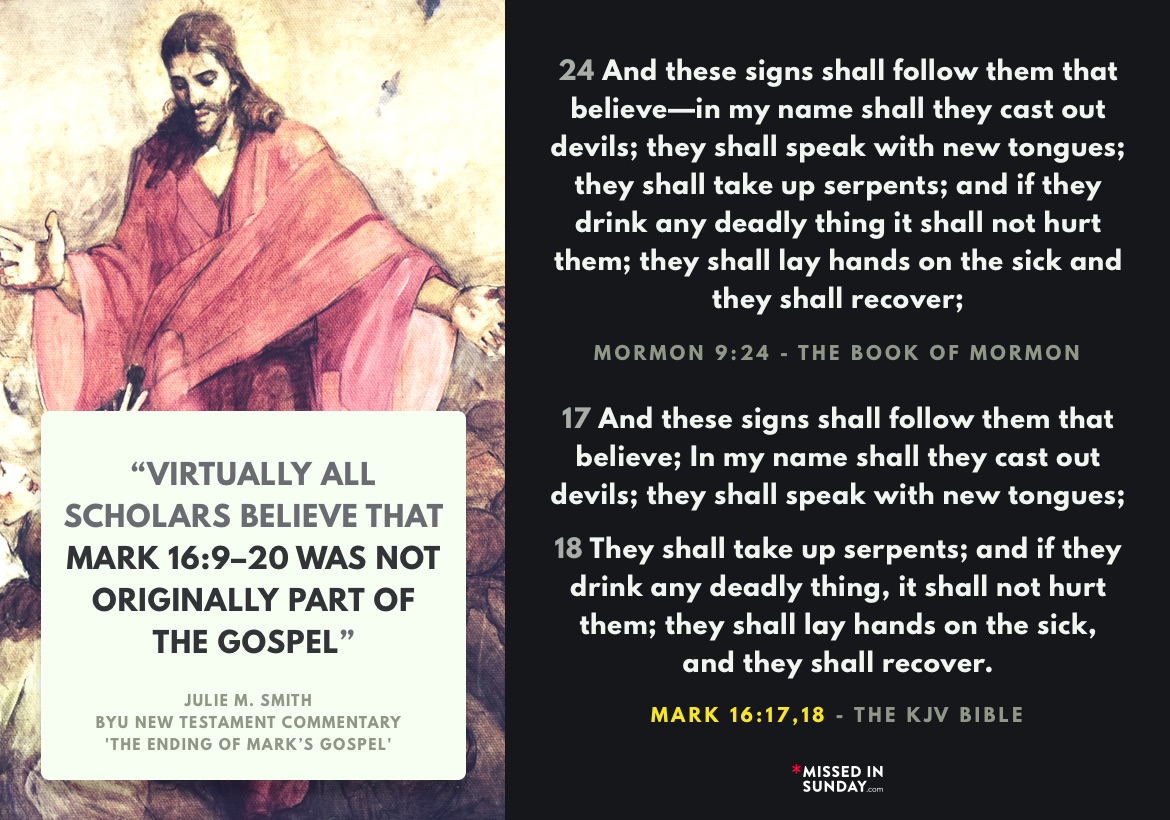Mormon 9:22–24, the Book of Mormon: 1
22 For behold, thus said Jesus Christ, the Son of God, unto his disciples who should tarry, yea, and also to all his disciples, in the hearing of the multitude: Go ye into all the world, and preach the gospel to every creature;
23 And he that believeth and is baptized shall be saved, but he that believeth not shall be damned;
24 And these signs shall follow them that believe—in my name shall they cast out devils; they shall speak with new tongues; they shall take up serpents; and if they drink any deadly thing it shall not hurt them; they shall lay hands on the sick and they shall recover;
Mark 16: 15-18, the KJV Bible: 2
15 And he said unto them, Go ye into all the world, and preach the gospel to every creature.
16 He that believeth and is baptized shall be saved; but he that believeth not shall be damned.
17 And these signs shall follow them that believe; In my name shall they cast out devils; they shall speak with new tongues;
18 They shall take up serpents; and if they drink any deadly thing, it shall not hurt them; they shall lay hands on the sick, and they shall recover.
Excerpt from a BYU’s New Testament Commentary article by Julie M. Smith, ‘The Ending of Mark’s Gospel‘: 3
Virtually all scholars believe that Mark 16:9–20 was not originally part of the Gospel for the following reasons:
- Some ancient manuscripts lack it and some of those that include it have a note that the text is disputed.
- It is difficult to imagine why a copyist would omit it; it is much easier to imagine a copyist adding it.
- Several early Christian writers appear to know copies of the Gospel of Mark that do not include Mark 16:9-20.
- Most scholars find the style and theology of Mark 16:9–20 to differ substantially from the rest of the Gospel.
- Matthew and Luke follow Mark pretty closely until they get to Mark 16:8, and then they go in very different directions, which suggests that they had copies of Mark that ended at Mark 16:8.
- The transition between 16:8 and 16:9 is awkward: the subject shifts and the women in 16:1–8 are forgotten. Mary Magdalene is introduced to the audience as if they were unfamiliar with her despite the fact that she was mentioned just a few verses ago. (These problems not only suggest that Mark 16:9–20 was not original to Mark, but also that it wasn’t written afresh to end the text but rather was an already-extant writing added to fill a gap.
- There are over a dozen words included in Mark 16:9–20 that are not found elsewhere in Mark.
- The presence of multiple different endings strongly suggests that Mark 16:9–20 was not present originally. It implies that more than one person (or group) found Mark 16:8 to be inadequate and decided to add to the ending.
Additional Study
Mark 16, Wikipedia – https://en.wikipedia.org/wiki/Mark_16
A Text-Critical Comparison of the King James New Testament with Certain Modern Translations, BYU Studies, Lincoln Blumell – https://publications.mi.byu.edu/fullscreen/?pub=1471&index=5
References
| 1 | Mormon 9:22–24 – https://www.lds.org/scriptures/bofm/morm/9.22-24?lang=eng |
|---|---|
| 2 | Mark 16: 15-18 – https://www.lds.org/scriptures/nt/mark/16.15-18 |
| 3 | ‘The Ending of Mark’s Gospel’ Julie M. Smith – https://www.byunewtestamentcommentary.com/the-ending-of-marks-gospel/ |

